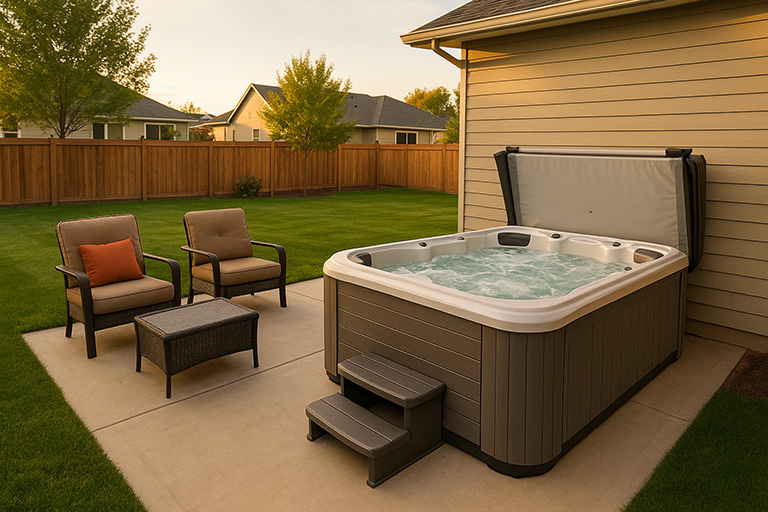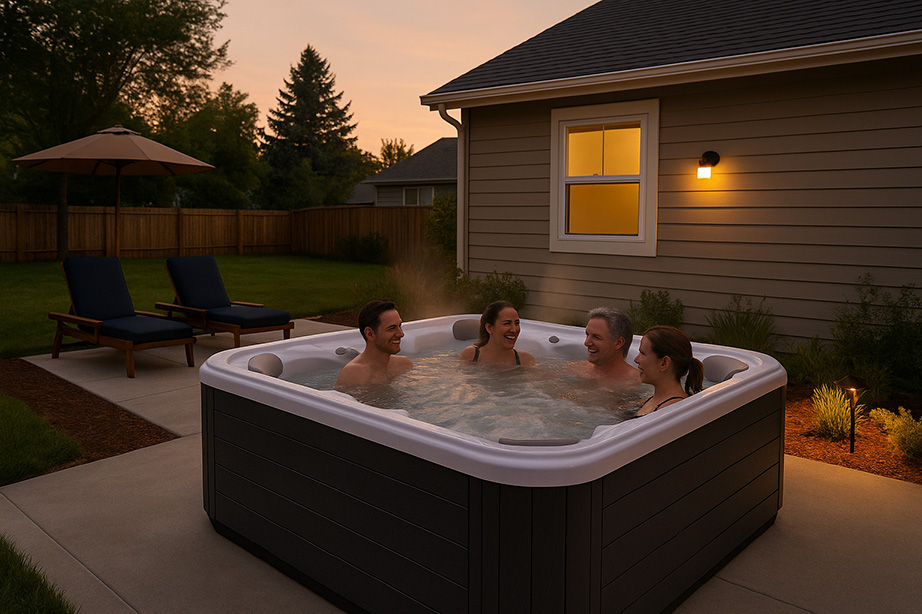Hot tubs (aka hydrotherapy or passive heat therapy) have surged in popularity—not just for relaxation but increasingly for their scientifically backed health benefits. Let’s explore what the research shows: from relaxation and cardiovascular gains to pain relief, better sleep—and yes, some caveats.
We are going to look at the science and see what benefit heat therapy (in the form of hot tubs) can provide.
We will look at six different areas in which hot tubs can have a positive impact on health and overall well-being.
1. Stress Reduction & Mental Well‑Being

Key takeaway: Even a single 30–60 min session can significantly calm the nervous system and lift mood—though not a replacement for therapy. This is why Hot Tubs have had a surge in recent years, as individuals and families see the benefit, not just for fun, but actual relaxation that is so valuable in 2025 and beyo
2. Muscle Relaxation & Pain Relief
- Heat and buoyancy decrease muscle tension, increase flexibility, and relieve joint stiffness—especially helpful for arthritis, fibromyalgia, and post-op rehab .
- A 2021 randomized study found hydrotherapy was more effective than standard physiotherapy for knee replacement recovery
Why it works: Water supports your body—reducing load—while heat increases blood flow and delivers oxygen/nutrients to sore tissues. From our understanding of heat and increasing the flow of blood in the muscles, we see a benefit of using Hot Tubs even for workout recovery.
3. Cardiovascular Benefits
- Warm soak raises heart rate, dilates blood vessels, and transiently lowers blood pressure
- A long-term Japanese study of 30,000+ individuals found regular hot-bathing was associated with reduced cardiovascular disease risk over 19 years.
- Heat therapy has comparable cardiovascular benefits to moderate exercise—one study equated an hour in 40°C water to a 30-minute jog.
- A 2024 UK pilot with type‑2 diabetics showed improved blood pressure and insulin sensitivity after eight sessions over two weeks thesun.co.uk, and a study done in 1999 showed that for patients with type 2 diabetes mellitus hot tub therapy was effective for sleep and general sense of well-being.
Bottom line: For those unable to exercise, regular hot tub use may meaningfully improve vascular health—but don’t skip medical clearance if you have heart conditions. And in general, its best not to use Hot Tubs to skip cardio or workouts from a health perspective, but rather for recovery. As with all health advice, it’s best to speak to your doctor about health factors affecting yourself.
4. Better Sleep
- Elevated body temperature followed by cooling post-soak triggers melatonin release and promotes sleep, improving scores on the Pittsburgh Sleep Quality Index healthline.com.
- Relaxation and reduced cortisol also help with falling and staying asleep.
Tip: Aim for a soak 1–2 hours before bedtime—not immediately before—so your body can cool down naturally.
5. Improved Metabolism & Insulin Sensitivity
- Heat exposure reduces fasting glucose and insulin levels; a 2018 trial showed significant drops after 10 immersion sessions in overweight men.
- Enhanced blood flow further supports metabolic health.
6. Immune System & Cellular Repair
- Heat stimulates the production of heat shock proteins (HSPs), which assist in cellular repair & resilience to stress.
- Increased white blood cell activity has also been observed after regular hot-soak routines.

Potential Risks & Downsides
- Infections – Poorly maintained tubs harbor bacteria like Pseudomonas aeruginosa (folliculitis), Legionella, and non-tuberculous mycobacteria (hot-tub lung) (so regular cleaning of your hot tub is a vital step in your health)
- Overheating or hypotension – High temps may cause dizziness, fainting, or dangerously low blood pressure.
- Pregnancy – Warming above 39 °C poses risks in the first trimester; best to avoid hot tubs entirely.
- Cardiovascular caution – Those with unstable heart conditions should consult a physician before use .
- Skin irritation – Chlorine or bromine can irritate susceptible skin; showering after use helps.
Practical Guidelines for Safe, Effective Use
- Temperature- Keep at or below 104 °F (40 °C); 100–102 °F (37–39 °C) is ideal
- Duration- 10–20 min at higher temps; up to 60 min at lower temps
- Hydration- Drink water before and after soaking
- Maintenance- Maintain sanitizer levels and clean filters to avoid infections
- Medical clearance– Especially important for pregnant women, heart issues, low BP, or chronic conditions
Summary
Scientific evidence supports many health benefits of hot tubs—including improved stress, pain relief, sleep quality, cardiovascular function, metabolism, and cellular resilience—especially for those limited in traditional exercise. However, benefits hinge on safe water maintenance, responsible usage, and medical vetting. When used properly, hydrotherapy can serve as a powerful wellness tool.
At Love’s Hot Tubs, we are the experts in everything Hot Tubs. Call us with any questions you have and set up an appointment to see us and various Hot Tubs that support your unique lifestyle.

